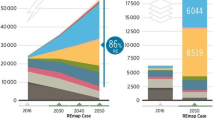Abstract
Solar power is an unlimited source of power in theory when compared to the needs of the planet, however, in practice it is still a source of power convertible to electrical energy on a limited basis. In this context, efficiency of this energy conversion by photovoltaic panels has a great importance. Panel surface taking a sufficient amount of light at the right angle has a direct effect on efficiency. This is related to keeping the panel surface as clear as possible of dust and similar objects which can be reflective and absorptive. The contamination of photovoltaic panels has a negative effect on the energy production of panels. In this study, the effect of panel surface contamination, one of the most important factors affecting panel efficiency, was investigated. The investigation was conducted by comparing data from two panel strings standing very close to each other in a plant, one of which was cleaned regularly and the other left contaminated.
Similar content being viewed by others
References
Adoption of the Paris Agreement. Proposal by the President, Proc. 21st UNFCCC Conf. of the Parties (COP), Paris Climate Change Conf., Paris, Nov. 30–Dec. 11, 2015. http://unfccc.int/resource/docs/2015/cop21/eng/l09r01.pdf.
Wetstone, G. and Thornton, K., Renewables 2016 Global Status Report United Arab Emirates, 2016. http://www.ren21.net/wp-content/uploads/2016/05/GSR_2016_Full_Report_lowres.pdf.
Stridh, B., Evaluation of economical benefit of cleaning of soiling and snow in PV plants at three European locations, Proc. IEEE Photovoltaic Specialists Conf., Austin, 2012, pp.1448–1451.
Gostein, M., Caron, J.R., and Littmann, B., Measuring soiling losses at utility-scale PV power plants, Proc. IEEE 40th Photovoltaic Specialist Conf. PVSC 2014, Denver, 2014, pp. 885–890.
Guo, B., et al., Effect of dust and weather conditions on photovoltaic performance in Doha, Qatar, Proc. 1st Workshop on Smart Grid and Renewable Energy. SGRE 2015, Doha, 2015.
Yoldaş, Y. and Teke, A., Fotovoltaik Sistemlerin Performansini Etkileyen Faktörler, Proc. 8th Yenilenebilir Enerji Kaynaklari Sempozyumu, 2015, pp. 37–41.
Haydaroglu, C. and Gumus, B., Performance analysis of grid connected 250 kWp Dicle University Solar Power Plant in Diyarbakir/Turkey and comperation with simulation results at winter conditions, Proc. 6th Int. 100% Renewable Energy Conf., Istanbul, 2016, pp. 60–65.
Haydaroglu, C. and Gumus, B., Dicle Univeritesi Gunes Enerjisi Santralinin PVsyst ile Simulayonu ve Performans Parametrelerinin Degerlendirilmesi, DUMF Muhendislik Dergisi, 2016, vol. 7, no. 3, pp. 491–500.
Author information
Authors and Affiliations
Corresponding author
Additional information
The article is published in the original.
About this article
Cite this article
Haydaroğlu, C., Gümüş, B. Investigation of the effect of short term environmental contamination on energy production in photovoltaic panels: Dicle University solar power plant example. Appl. Sol. Energy 53, 31–34 (2017). https://doi.org/10.3103/S0003701X17010066
Received:
Published:
Issue Date:
DOI: https://doi.org/10.3103/S0003701X17010066




